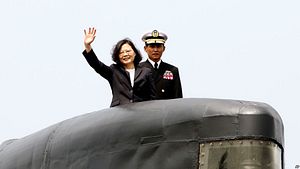Taiwan-based China Shipbuilding Corporation (CSBC), the country’s only listed shipbuilder, and the Chungshan Institute of Science and Technology signed a memorandum of understanding (MOU) with the Republic of China Navy (ROCN) for the construction of a yet to be determined number of diesel-electric attack submarines this week, according to local media reports.
The so-called Indigenous Defense Submarine (IDS) program will be divided up into two main phases, the MOU said.
The first phase consists of completing design work on Taiwan’s new class of attack subs for the government allocated approximately NT$2 billion ($65.66 million). The second stage entails the construction of the new boats with the ambitious goal of finishing construction in eight years and commissioning the subs into service with the ROCN within a decade. (Each sub could cost as much as $1 billion, according to The Diplomat estimates.)
The head of CSBS, Cheng Wen-lung (鄭文隆), did not reveal additional details merely noting that the new submarine class’ design “will be based on a model that meets the needs of Taiwan’s self-defense.” The MOU signing ceremony at the ROCN’s main base in Tsoying was witnessed by President Tsai Ing-wen (蔡英文).
“During the election, I promised Taiwan will develop a more robust defense industry. Today marks an important step forward in this area,” the president said. “Under the strategic concept of effective and multilayered deterrence, subsurface combat ability is what Taiwan’s defense is most in need of strengthening. This is a problem that everyone is aware of but which in the past we were never able to resolve.”
While at the naval base, the president also boarded a Dutch-built Hai Lung-class (improved Dutch Zwaardvis-class) submarine and watched s simulated torpedo launch. As I reported in September 2016, the United States agreed to supply Taiwan with new MK-48 Mod 6 Advanced Technology (AT) heavyweight torpedoes, which the ROCN had first requested during the presidency of George W. Bush.
The ROCN currently operates two Hai Lung-class and two U.S.-built Guppy II-class subs, the latter, however, are only used for training purposes. In April 2016, Taiwan announced a $12.35 million life extension upgrade of the two Hai Lung-class boats— the Hai Lung (Sea Dragon) 793 and Hai Hu (Sea Tiger) 794. The overhaul, which includes equipping the subs with a new combat system, is slated extent their service lives for at least another 15 years.
The ROCN plans for a fleet of eight attack submarines with the first boat entering sea-trials by 2024 and a 2016 commissioning date. Should Taiwan intend to keep to this ambitious timetable it will need to overcome a number of political obstacles, as I explained elsewhere:
Taiwan lacks the expertise to jumpstart such an ambitious defense program and delays as well as cost overruns will be likely. European and American shipbuilders will, in all likelihood, help in some capacity, although it appears improbable that the United States or European countries will agree to substantial technology transfers for an indigenous submarine program given the People’s Republic of China’s likely reaction and the threat of an overall deterioration of China-West relations.
During the MOU signing ceremony, Cheng Wen-lung admitted that Taiwan lacks expertise in submarine construction, but expressed confidence that all difficulties could be overcome.
The IDS program was first announced in December 2014, following the realization that the 2001 commitment by the Bush administration to help Taiwan acquire or built eight diesel-electric submarines would not be supported by the Obama White House. U.S. President Donald Trump has so far not indicated his stance on the matter. Regardless, U.S. technical support may be of limited value in any case given that no American shipyard has built a diesel electric submarine since the 1950s.































